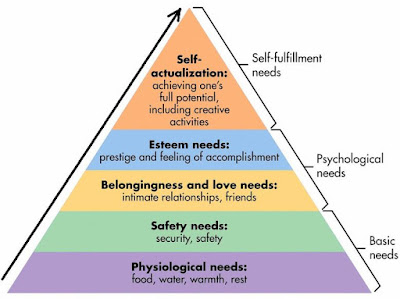What Do We Need to Learn? How Maslow's Hierarchy of Needs Proves Coregulating Activities to Work
When we think about the ideal classroom, as educators, we might imagine a place of order, kindness, and curiousity that would support every student in reaching their full learning potential. But how do teachers successfully mold their practices to shape such an ideal space? Reading about developmental theories for my Adolescent Development class, I have come across Maslow's Hierarchy of Needs, which I have found particularly interesting. Maslow describes the basic needs that every person needs before they are able to reach self actualization, or, in context of a classroom, reach a point where they can attain their full learning potential. It makes sense that students would first need to have basic needs fufilled such as hunger, thirst, sleep, and safety to be able to perform in the classroom. When our bodies enter survival mode, it is impossible to think about anything other than fufilling these needs. As we move up into the next two tiers in Maslow's theory, I understand the importance of community in a classroom, but if a highly motivated, intelligent student does not reach these needs, is it possible for this student to still succeed? Is it even possible for this student to be highly motivated? In some cases, yes, but if he does not have his belonging and love needs as well as his esteem needs fufilled, it is not possible for this motivation to reach its peak. Some students in the same situation who have experienced trauma or live with naturally higher levels of anxiety may not be able to succeed at all if they do not have these two tiers met. As educators, we must do more than provide students with a basic education, we must provide them with a sense of belonging.
I am currently in a class titled Teaching Inclusive Elementary Classrooms, where we focus on classroom strategies to maximize learning for young students with disabilities, ELL students, students who have experienced trauma, or have a difficult time managing their anxiety or disruptive behavior in a classroom. As I have found in this class, forming the classroom into a social environment where students do not feel stress to please their teacher is beneficial from a very young age. Teachers in elementary classrooms use coregulating activities, such as low risk games, coloring, meditation, etc. to lower the anxiety levels and build trust between teacher and student. The students should feel as if the teacher and their peers want them in the classroom. The idea of coregulation, or that students feed off of the energy of the adult in the room, is an important concept to remember as a future educator. If the teacher is angry or raises her voice at her students, the students feel a heightened level of stress that affects esteem and love and belonging needs.
This concept reigns true from a young age of life: infantry. Even as babies, we coregulate through the emotions of our parents, showing that this is a social function we have since birth. In my Inclusive Classrooms class, we watched this video to illustrate that when babies cannot receive positive energy from their mothers, the high levels of stress cause their muscles in their bodies to quite literally shut down. The babies cannot focus on anything other than obtaining the attention they need to fufill their own love and belonging and esteem needs.
If we find that these needs on Maslow's pyramid are relevant from the womb, it should be clear that the theory proves true. If coregulating activities are recommended in elementary classrooms, shouldn't they be especially emphasized in middle and high school when adolescents become especially sensitive to social interactions and their peers' opinions of them? When adolescents are in a stage where it is crucial that they feel accepted, I believe that their teachers are especially responsible for creating an environment where students can fufill all of Maslow's needs. It is proven that students feed off of their teacher's energy, so in a time where students' anxiety levels are increasingly higher and higher, it is important that the teacher maintains a collected, accepting, and positive environment for students to learn.

Meghan, this is a very interesting and thoughtful post. I appreciate the connections between your coursework in different classes as it communicates your ability to generalize and apply the information.
ReplyDeleteI enjoyed reading about the co-regulating activities and the different options in a classroom. I especially liked the coloring example because I think this is a low-stress activity for any age group that can put you into a type of meditation. There is something extremely relaxing about this activity, but I never thought much about how I could implement it into my classroom until now. I think about all of the adult coloring books I see in the stores nowadays in addition to the ones for children.
ReplyDelete